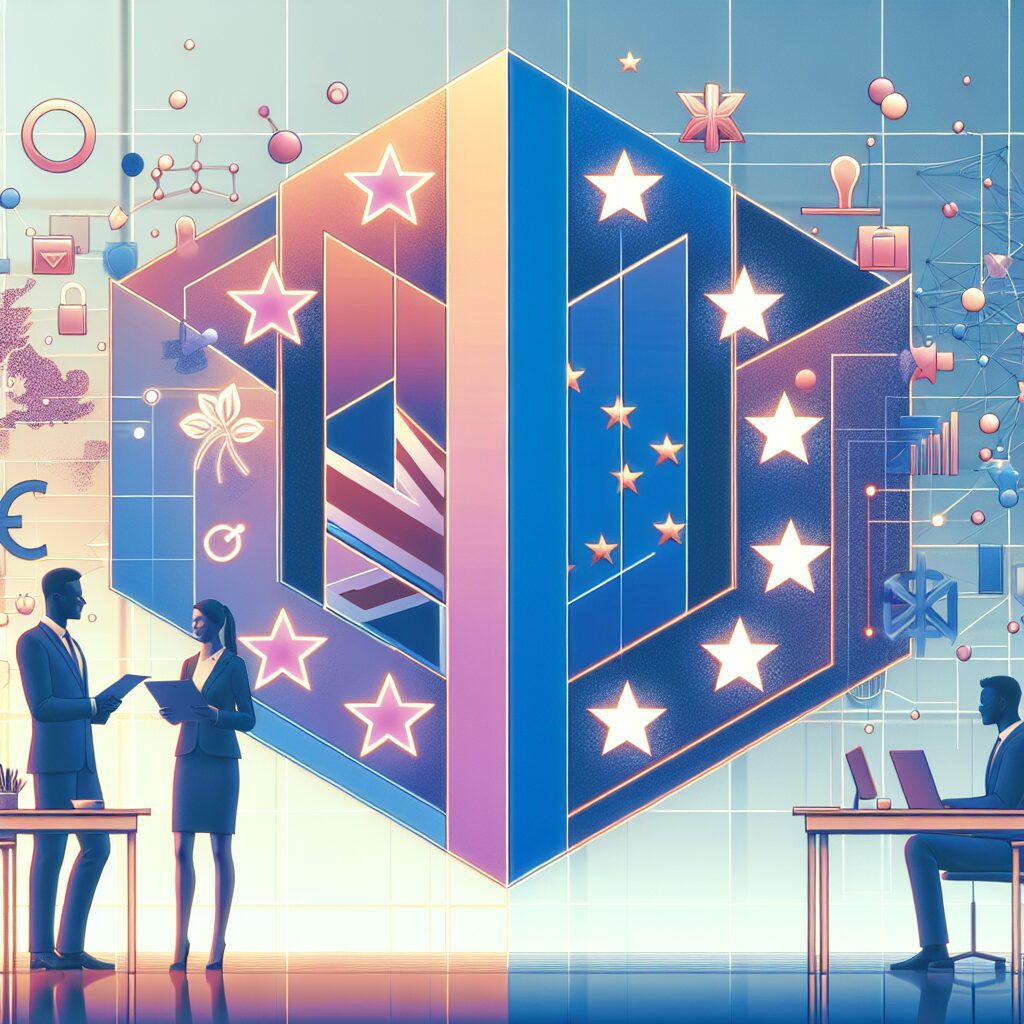About eldris
At Eldris, we automate SEO, multilingual site expansion, and EU compliance for brands scaling across Europe. Our AI-powered platform handles everything from content publishing to regulatory docs—so you don’t have to.
In This Article
- Post-Brexit divergence has created distinct UK and EU compliance frameworks.
- Legal compliance software enables harmonised oversight despite regulatory fragmentation.
- Designating a Responsible Person remains vital for EU market access.
- Unified platforms like Eldris automate, monitor, and scale compliance workflows cross-regionally.
- Manual compliance processes increase risk; automation delivers legal resilience and speed.
Understanding UK Compliance Regulations Post-Brexit
The Regulatory Landscape in the UK
The departure of the United Kingdom from the European Union in 2020 introduced significant regulatory ramifications for product manufacturers, importers, and distributors. While many EU laws were initially transferred directly into UK law via the European Union (Withdrawal) Act 2018, progressive divergence has increased the challenge for organisations trying to maintain compliance across UK and EU markets. In this context, legal compliance software plays a vital role, ensuring that companies stay abreast of nuances in legislation, documentation standards, and labelling rules that differ between jurisdictions.

How EU Product Compliance Works Today
EU Requirements and the ‘Responsible Person’
The European Union maintains a harmonised regulatory framework that governs product safety, environmental impact, and market access criteria. For products sold within the EU, legal compliance software assists companies by automating documentation such as CE declarations, usability testing reports, and conformity assessments. A key feature of EU compliance is the designation of a ‘Responsible Person’. This entity, based within the EU, holds accountability for ensuring and demonstrating product compliance with relevant EU legislation. Without this designation, non-EU businesses may be barred from selling their goods in the European Single Market.
“The Responsible Person serves as the legal bridge between your brand and EU regulators—without one, you risk market exclusion.”
Comparing UK and EU Regulatory Frameworks
Although derived from common roots, UK and EU compliance regimes have grown distinct in the post-Brexit era. For instance, the UK uses the UKCA (UK Conformity Assessed) mark instead of the EU’s CE mark. UK regulations are now enforced by local bodies such as the Office for Product Safety and Standards (OPSS), whereas the EU’s enforcement relies on centralised agencies and member state authorities. Legal compliance software must account for differing timelines, templates, and auditing requirements. Therefore, businesses relying on manual compliance tracking often face delays due to duplicative efforts or misinterpretation of jurisdiction-specific rules.
Selecting Multi-Region Compliance Tools
When searching for an effective legal compliance software platform, organisations operating in both UK and EU jurisdictions require tools that cater to both regulatory spheres. These solutions should support automatic localisation of regulatory updates, version management of compliance documents, and region-based workflows. Additionally, multi-region support helps simplify cooperation with third-party providers and subcontractors who may operate under different legal expectations. The most robust platforms integrate compliance intelligence, giving legal and operations teams a shared dashboard that highlights jurisdictional gaps before they become legal liabilities.
Why Responsible Person Designation Changes EU Access
The ‘Responsible Person’ requirement significantly impacts market entry for non-EU businesses. Under EU regulations, the Responsible Person must reside in the EU and maintain comprehensive product documentation, including technical files, safety reports, and compliance statements. Legal compliance software facilitates this process by consolidating the necessary data and enabling permission-based access to ensure compliance records are accessible to designated representatives. Moreover, when a product portfolio evolves, the software helps ensure updates are synchronised between the third-party Responsible Person and the manufacturer, thereby reducing delays in certification or sales rollout.
Operational Challenges for Multinational Compliance
Compliance across multi-jurisdictional territories introduces a wide array of logistical, technical, and operational challenges. Chief among them is the ability to keep pace with the continuous changes in legislation. Regulatory divergence means that what complies in the EU may no longer be sufficient in the UK, and vice versa. Legal compliance software addresses this issue by offering real-time regulatory alerts and collaborative functionality among compliance officers, legal teams, and product developers. In addition, such platforms provide audit trails and documentation logs which are essential for responding swiftly to regulatory audits or enforcement actions.
Checklist for Choosing Legal Compliance Software
Prioritising functionality relevant to your operations is critical when choosing legal compliance software. A comprehensive checklist includes:
- Multi-jurisdictional support (UKCA, CE, REACH, RoHS)
- Automated updates on legislation changes
- Cloud-based document storage and advanced permissions
- Templates for declarations and conformity assessments
- Integration with ERP and supply chain systems
- Reporting dashboards for real-time compliance status
- Multi-language interface support for international teams
Fulfilling these criteria ensures scalable compliance across both EU and UK, enabling your organisation to react effectively to any regulatory modifications. For additional guidance, consider Learn more about International regulatory compliance for businesses which offers expert insights on selecting enterprise-grade compliance platforms.
Benefits of Unified Compliance Management Platforms
Working with a unified legal compliance software platform unlocks several strategic benefits. First, it allows for greater governance consistency. By maintaining centralised data repositories and workflow automation, companies significantly reduce the risk of missed deadlines and inconsistencies in documentation. Second, it enhances decision-making. Access to cross-border compliance intelligence enables leadership teams to assess market entry feasibility with immediate clarity. Lastly, unified platforms support improved collaboration. With teams often distributed across regions, centralisation allows real-time access and cooperation, streamlining both new product introductions and ongoing quality assurance measures.
Case Studies: UK vs EU Compliance in Practice
A consumer electronics company based in Manchester encountered complications when expanding into Germany due to misunderstandings about the Responsible Person designation. Using a robust legal compliance software solution, the business quickly identified non-conformity in its documentation and engaged a local representative, resolving the issue efficiently. Conversely, a London beauty brand failed to meet the EU’s Cosmetics Regulation due to outdated safety assessments. Without proper software in place, the company incurred a six-month delay in accessing the French market. These examples underline the criticality of consistent, software-supported compliance for smooth operations across distinct legal regimes. Explore more case studies via Read a related article.
Common Pitfalls When Aligning Regulatory Strategies
Businesses often err by assuming legal parity between UK and EU frameworks. This can lead to compliance breaches, especially in sectors like chemicals, electronics, and cosmetics. Overreliance on outdated spreadsheets or siloed databases exacerbates this risk. Moreover, failure to appoint a qualified Responsible Person for EU markets or an Authorised Representative in the UK causes avoidable sales disruptions. Legal compliance software prevents these pitfalls by providing intelligent reminders, accountability chains, and automated file generation. Integration with supply chain partners also ensures that third-party documentation meets required jurisdictional standards—thereby eliminating bottlenecks before shipments leave warehouses.
Using Eldris to Automate Legal Compliance Workflows
Eldris offers a comprehensive platform that automates and centralises regulatory workflows across the UK and EU. Designed with cross-border functionality in mind, its legal compliance software modules include dynamic regulatory mapping, intuitive dashboards for workflow monitoring, and AI-driven alerts tailored to industry-specific requirements. Whether you’re introducing new products or updating technical documentation, Eldris helps ensure every step complies seamlessly with the relevant regulations. Moreover, the platform supports Responsible Person collaboration and provides full traceability for audits, making your compliance operations both robust and scalable. For official regulations, visit Industry-leading UK compliance solutions overview.
Conclusion: Centralised Tools for a Changing Landscape
[CONCLUSION_CONTENT]
Great guide on uk-vs-eu-legal-compliance-solutions-explained – Community Feedback
What is the main difference between UK and EU compliance?
The UK and EU have distinct legal frameworks post-Brexit. The UK’s regulations increasingly diverge, while EU compliance often requires ‘Responsible Person’ appointments and multi-market oversight.
How do I choose the right legal compliance solution?
Assess your operational markets, required certifications, and the ability to update with regulatory changes. Choose solutions supporting both in-market nuances and centralised compliance management.
Why is it critical to align compliance strategies when expanding into the EU?
EU member states frequently enforce sector-specific regulations and cross-border requirements. Aligning your compliance approach reduces legal risks, accelerates market access, and streamlines growth.








